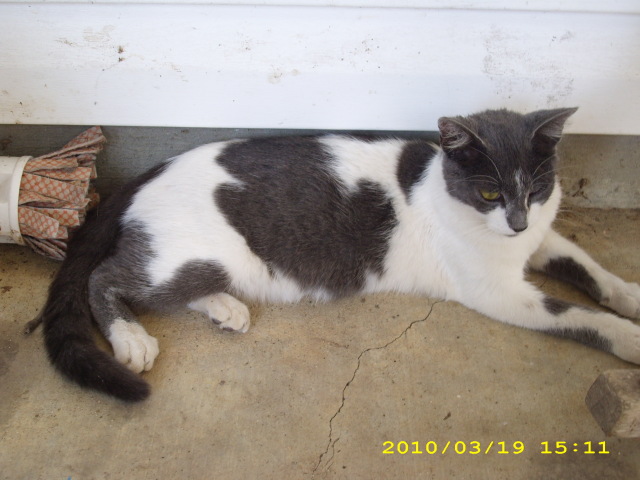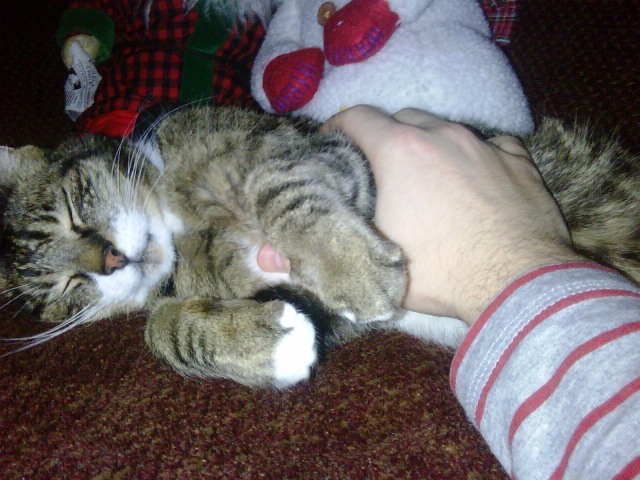QuestionHello,
I am Mohammedali here I am having 3 English cats 1 female cat and 2 male cat and upto 1 year they stayed along with each other in a good manner and a friendship but now from 10 to 15 days my two male cats started fighting against each other and one big male cat is getting frightened from a smaller one and stays hidden in cupboard or in a bed or somewhere else because of a smaller male cat as he attack him again and again.SO I can't understand dear what to do and how make friendship again with each other.Please guide me and send me the tricks and tips for making them again friends.
Thanking You
Your's faithfully
Mohammedali Sayeed
AnswerHi there,
Thanks for your question,
Sometimes getting cats to live together peacefully can be as difficult as trying to herd them. Others appear to get along famously. Why do some cats get along well together while others do not?
To answer this question it is helpful to know something about cats' natural inclinations toward each other. Cats are not, by nature, as sociable as dogs. When resources are scarce, as they are in nature, most cats have to get by pretty much on their own and do not seem to need or seek company. There are a few exceptions to this: mating time, kitten nursing/rearing time (for females only), and congregation time for itinerant urban males off their own territory. No one is quite sure of the purpose of these latter gatherings, which often occur in the back alleys off busy city streets. At these times, the cats simply sit and look at each other from a distance.
When there is ample food for all, cats have the leisure to live together in harmony, if they wish. Under these circumstances groups of 70 or more cats can live together with some degree of mutual harmony in a unit that has been found to be a true society, not simply an aggregation of animals of the same species around a common food source.
In the "cat society," females tend to form alliances and share some of the duties of kitten-raising to their mutual benefit. They will, for example, cross suckle and engage in cooperative hunting. Males patrol territories in which groups of females reside and, like the males of many species, seem indifferent to the social side of things. Their job is to feed themselves and procreate.
Within these large groups of cats, it has been found that certain individuals spend more time than the average in close proximity to each other. These cats have been termed "preferred associates," or what you and I would call friends. They show some affinity for each other. Other cats distance themselves from each other and might be referred to non-preferred associates or as showing a degree of antagonism toward each other. Preferred associates communicate their affection for each other in subtle ways, such as momentary bunting and flank rubbing, or they may actually allow each other inside their personal space, grooming each other and curling up together.
In the Home
This is (or should be) the situation in our homes, allowing cats to live together in a society. The term society implies some sort of civil code of conduct and perhaps some social ranking system. Both appear to exist, at least on occasion, in groups of cats in the home. One type of social arrangement occurs when a leader cat controls the whole group. This is referred to as a despotic hierarchy. All other cats are equal in terms of access to valued resources, with the exception of the occasional pariah cat that in nature normally would be excluded from the group and driven away.
Other times, the order is less easy to see and may take the form of a "time-sharing cooperative." The leader may have the favored spot on the windowsill in the sun in the morning, turning it over without fuss to another cat in the afternoon.
All these hierarchical concerns occur at a level barely detectable to us body-language blind humans. Not only do we not appreciate the subtleties of our feline companion's social structure but we also transgress by breaking certain unwritten rules.
Common Mistakes
When we have only one cat, we assume that the addition of any other cat will provide social and environmental enrichment.
Because we have two or three cats who get along well together, we assume a third cat will cause no trouble.
We assume that reuniting siblings is a cinch.
If they don't get along at first, they will eventually.
The Truths
Some cats are better kept as only cats.
Stable societies can be destabilized by the addition of a new cat.
When there are more than 10 cats in a household there is inevitably a behavior problem related to inter-cat friction.
Neither new kittens or siblings have carte blanche when introduced/reintroduced into a home.
"Trial marriages" should always precede permanent residency.
When introducing a new cat do it from behind closed doors. Proceed with the gradual introduction only as long as peace permits.
Some cats will never get along.
When we get another cat, whether for ourselves, or ostensibly for another cats' pleasure, we destabilize their order. We work on the basis that the addition of another cat will be accepted sooner or later. Nothing could be further from the truth. Cats, as it turns out, are a bit like us. Some other cats they like, others they do not, and never will. Luckily for us, most cats are not in the second category and will come round in time, as long as we play our cards right.
The fact is that when cats are introduced, many will initially show some degree of aloofness or animosity toward each other. Resident cats has squatters' rights but matters of individual temperament can overturn any theoretical "rights." Some degree of overt aggression, often confined to growling and hissing, often occurs initially when cats are first introduced, but the hostilities will usually melt away over time until natural harmony is achieved in a period of some 90 days. Aggression persisting after this time is termed territorial aggression and has its roots in both dominance and fearfulness.
The four possible end results are:
The cats get on just fine or even enjoy each other company.
The cats go through an initial reactive phase and then achieve mutual respect.
The cats fight, but can later be persuaded to tolerate each other.
The cats never get along, always fight, will always hate each other.
The ways to circumvent hostile relationships between housemate cats are:
Wait and see. Sometimes things improve.
Counterconditioning. Make sure that fun things happen when the two cats are together side by side, if at all possible.
Separate the cats and reintroduce them slowly, over months if necessary, under pleasant circumstances.
Find a home for one of the cats.
As you may have guessed, it is not always possible to get two cats to live together without hostilities occurring. Cats are more like humans than most of us would have ever imagined! When two cats are apparently incompatible, it may be possible, working with a behaviorist, to defuse overt aggression and allow the pair to live together in mutual indifference, if not harmony. In many instances, even mutual indifference would be an acceptable conclusion to the owners.
Barring occasional oil and water personality mixes, owners often find that problems between cats often do settle eventually and sometimes relationships between cats positively blossom. As mentioned, there is no absolute way to tell which cat is going to react in which way and which ones will reconcile their differences in due course. It's mainly a matter of trial and error ... and luck. Cat personality-wise, good omens for a successful blend include a history of proper socialization, no prior history of inter-cat aggression (either as aggressor or recipient), curiosity, and a calm even-tempered personality. With all these factors present in the cats to be brought together, the mix should be just purr-fect.
Hope this helps,
Ben.

 Identifying kittys breed
Question
Moggie
Hi I have a gorgeous ginger moggie I wa
Identifying kittys breed
Question
Moggie
Hi I have a gorgeous ginger moggie I wa
 my cat had a kitten with one head and part of another with a mouth and has not nursed since she was born.
Question
my newborn kitten
my cat delivered a female ki
my cat had a kitten with one head and part of another with a mouth and has not nursed since she was born.
Question
my newborn kitten
my cat delivered a female ki
 Strange litter tray behaviour
Question
Edgar
I have a beautiful two year old n
Strange litter tray behaviour
Question
Edgar
I have a beautiful two year old n
 My cat, Spots
QuestionQUESTION: Hi. My cat Spots is a wonderful cat.
My cat, Spots
QuestionQUESTION: Hi. My cat Spots is a wonderful cat.
 brother and sister loss of cat (16 years)
Question
Jesse on Xmas 2009, Re
kate -
my name
brother and sister loss of cat (16 years)
Question
Jesse on Xmas 2009, Re
kate -
my name